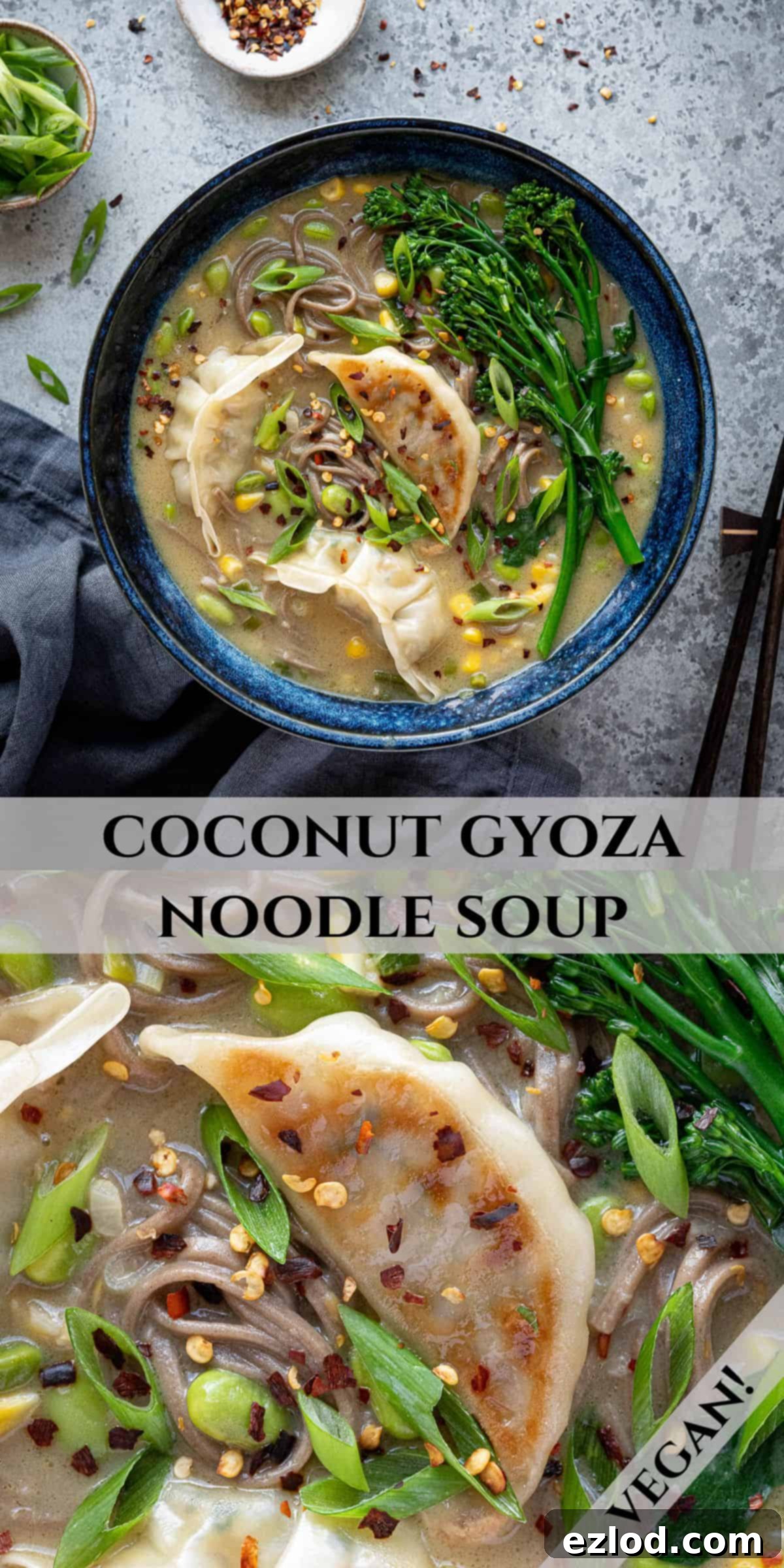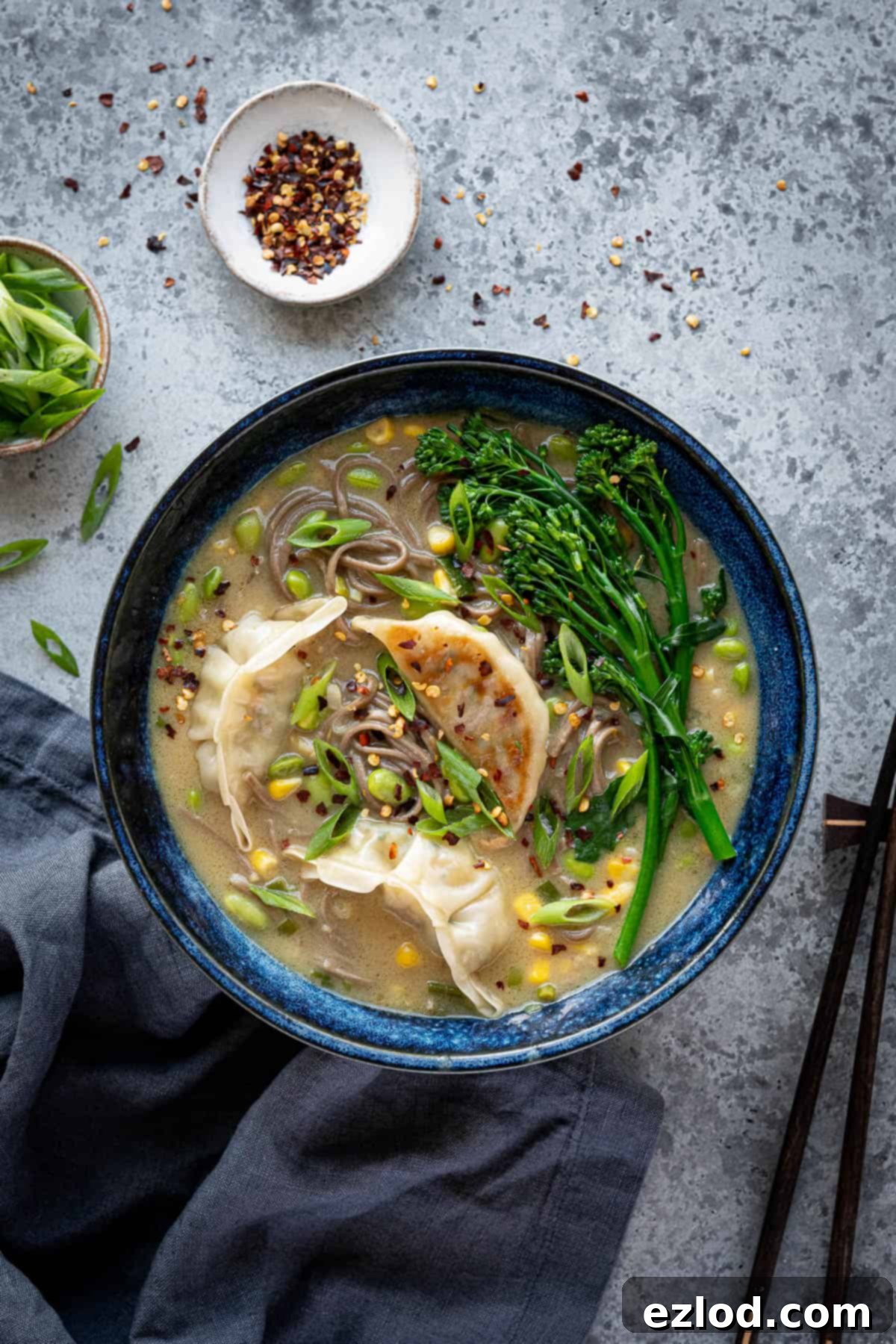The Ultimate Guide to Easy Vegan Coconut Gyoza Noodle Soup: Quick, Flavorful, and Wholesome
Discover the delightful world of **Vegan Coconut Gyoza Noodle Soup** – a dish that masterfully combines rich flavors with incredible ease of preparation. This recipe isn’t just another meal; it’s a culinary hug in a bowl, perfect for those bustling weekdays when time is a luxury but a hearty, satisfying dinner is a necessity. Forget complicated cooking; this soup is designed for simplicity without compromising on taste, making it an instant favorite for anyone seeking a wholesome, plant-based meal that comes together in under 30 minutes.
Whether you’re a seasoned vegan chef or just exploring plant-based options, this soup offers a vibrant fusion of creamy coconut milk, savory gyoza, and slurp-worthy noodles, all enveloped in an aromatic, spiced broth. It’s the kind of dish that adapts beautifully to whatever fresh or frozen vegetables you have on hand, transforming simple ingredients into a gourmet experience. Get ready to add a new staple to your recipe repertoire that promises comfort, convenience, and unparalleled flavor.
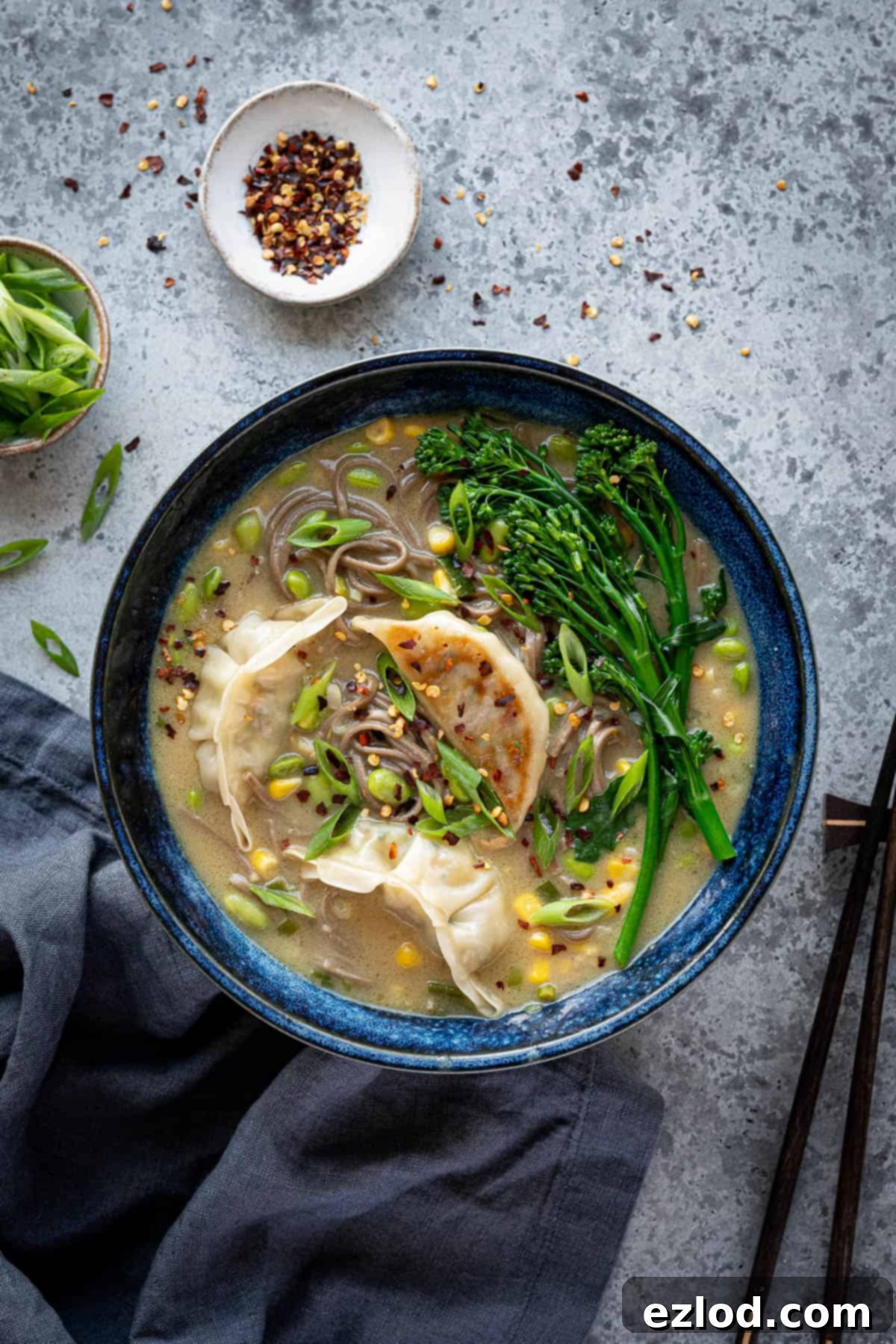
Why This Vegan Coconut Gyoza Noodle Soup Will Be Your New Go-To
There are certain recipes that become integral to your cooking routine, and for me, this **Vegan Coconut Gyoza Noodle Soup** is undoubtedly one of them. It’s the meal I turn to after a particularly demanding day, when the thought of elaborate cooking feels daunting, or when I arrive home late from an intense climbing session, craving something nourishing and substantial immediately. This soup isn’t just fast; it’s genuinely satisfying and packed with flavor, effortlessly ticking all the boxes for a perfect weeknight dinner.
Its brilliance lies in its simplicity and versatility. The robust flavors and comforting warmth make it an ideal choice for any season. The ability to customize it with readily available ingredients means you can enjoy a different iteration every time, preventing meal fatigue. From using a medley of whatever vegetables are in your fridge or freezer, to adding extra protein like fried tofu or tempeh, or even swapping noodles for pasta in a pinch, this recipe is designed to be flexible, catering to your preferences and pantry stock. It truly embodies quick, adaptable, and utterly delicious vegan cooking.
Essential Ingredients for Your Vegan Coconut Gyoza Noodle Soup
Creating this flavorful soup requires a thoughtful selection of ingredients, each playing a crucial role in building its distinctive taste profile. Here’s a detailed look at what you’ll need to gather:
Vegan Gyoza: The Star Addition
While technically an optional topping, the gyoza elevate this soup from good to extraordinary. They introduce a wonderful textural contrast and a gourmet touch with minimal effort. I always keep a bag of vegan gyoza in my freezer, ready for quick meals. My personal favorites are the tofu and vegetable ones from Costco, but many major supermarkets now stock excellent vegan-friendly options from brands like Itsu. Look for varieties with a savory filling that complements the rich coconut broth. Pan-frying them before adding to the soup creates a lovely crisp exterior, though steaming them directly in the broth can also work if you prefer a softer texture.
Noodles: The Heart of the Soup
The beauty of this soup is its adaptability, especially when it comes to noodles. You can use virtually any type you prefer. I often reach for thick, chewy udon noodles for their satisfying bite, or wholesome wholewheat noodles for added fiber. Ramen noodles, rice noodles (vermicelli or flat), or even soba noodles would also work wonderfully. Just be mindful of the cooking times, as they vary significantly between types. For a truly unique twist, and in an absolute pinch, you could even use short pasta shapes, though the overall Asian-inspired profile would shift slightly.
Coconut Milk: For Creaminess and Flavor
Full-fat tinned coconut milk is indispensable here. It’s the secret to achieving that luscious, creamy texture and distinctive tropical sweetness that balances the savory elements. Don’t be tempted to use light coconut milk, as it won’t provide the same richness and depth of flavor. Look for good quality coconut milk with a high coconut extract percentage for the best results. It’s what transforms the broth into a velvety, indulgent experience.
Aromatic Base: Spring Onions, Ginger, and Garlic
These three ingredients form the aromatic foundation of the soup. They infuse the broth with a fresh, pungent, and warming flavor. To save precious time, I frequently use pre-chopped frozen ginger and garlic – it’s incredibly convenient and just as flavorful as fresh for soups. However, if you have fresh on hand, by all means, use it; just allow a few extra minutes for preparation. Finely slice the spring onions, mince the garlic, and grate the ginger to ensure their flavors fully integrate into the broth.
Flavor Enhancers: Soy Sauce and Toasted Sesame Oil
These are the backbone of the soup’s umami profile. Soy sauce provides a salty, savory depth; either dark or light varieties work, though light soy sauce is generally preferred for its cleaner flavor in broths. For a gluten-free version, be sure to use tamari. Toasted sesame oil adds a distinct nutty, earthy aroma that is quintessential to Asian-inspired dishes. It’s a finishing oil, so a little goes a long way to enrich the overall fragrance and taste.
Vegetable Stock: The Liquid Foundation
A good quality vegetable stock is crucial. Choose one whose flavor you genuinely enjoy, as it will significantly impact the final taste of your soup. I personally favor Marigold vegetable bouillon for its robust and well-rounded flavor. Since this soup incorporates additional salty ingredients like soy sauce and MSG, it’s wise to opt for a low-sodium stock or dilute your regular stock slightly. You can always adjust the seasoning at the end, adding more if needed, but it’s much harder to correct an overly salty soup.
Chilli Flakes: A Touch of Heat (Optional)
For those who appreciate a gentle kick, chilli flakes are a fantastic addition. They introduce a subtle warmth that complements the creamy coconut. You could also use finely chopped fresh red chili for a brighter, spicier note. If you’re not a fan of heat, simply omit them – the soup will still be incredibly delicious without them.
Your Choice of Vegetables: Fresh or Frozen
To maintain the “quick and easy” promise, I often rely on frozen vegetables. Edamame and sweetcorn are my go-to choices, adding vibrant color, texture, and natural sweetness. Steamed tenderstem broccoli florets are also a wonderful addition, providing a slight bitterness and pleasant crunch. Feel free to incorporate other favorites like sliced mushrooms (sautéed beforehand), spinach (stirred in at the end), or even thinly sliced carrots. The key is to choose vegetables that cook relatively quickly or prep them accordingly.
MSG (Monosodium Glutamate): The Umami Secret (Optional)
This ingredient is entirely optional, but I highly recommend it for an unparalleled depth of flavor. MSG amplifies the savory notes in the soup, creating a more rounded and satisfying taste experience. Often misunderstood, MSG is a naturally occurring amino acid, and a small pinch can make a significant difference in bringing out the best in all the other ingredients. If you’re hesitant, you can certainly skip it, but try it once and you might become a convert!
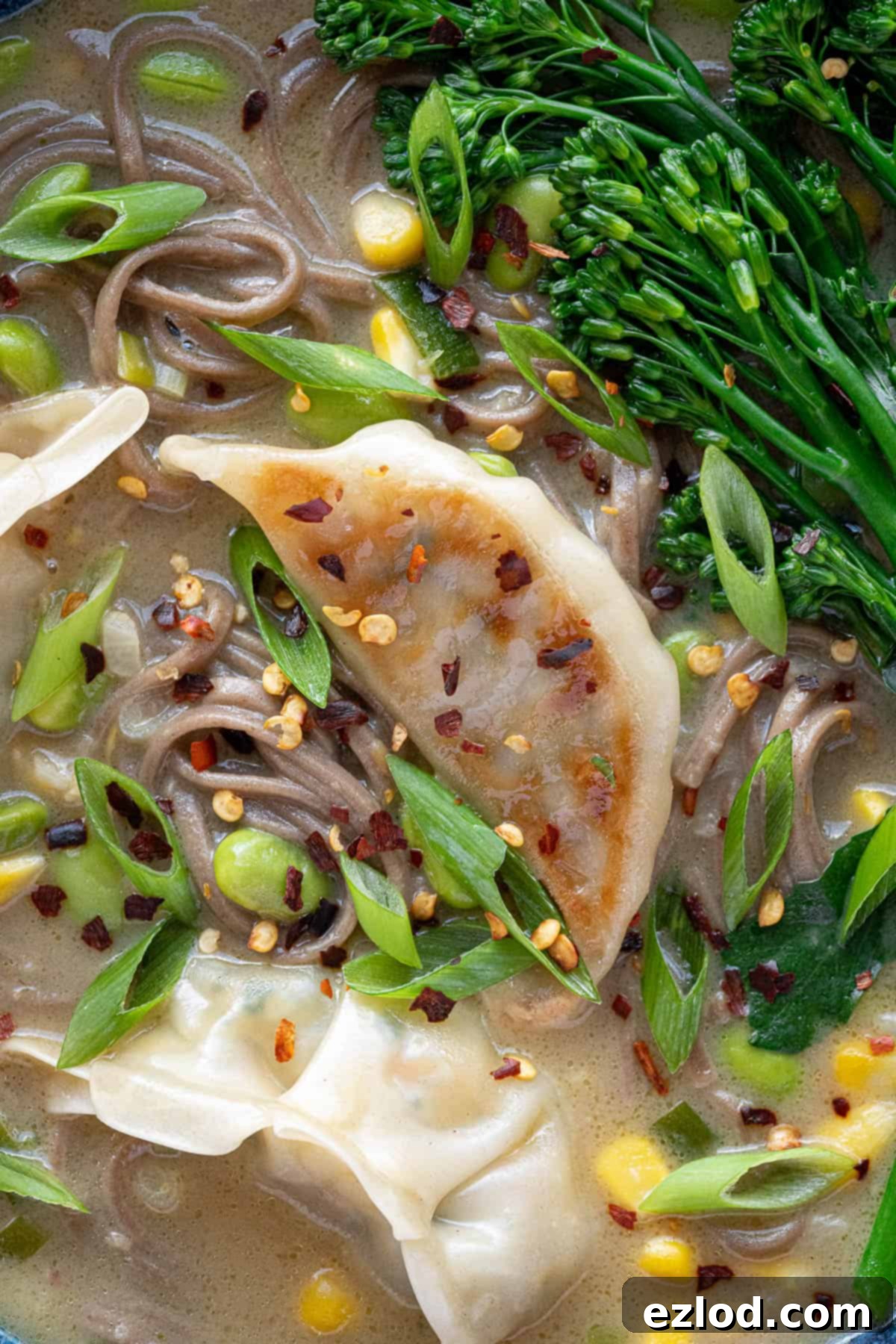
How to Make This Delicious Vegan Coconut Gyoza Noodle Soup
Creating this flavorful and hearty soup is surprisingly straightforward. Follow these simple steps for a delicious meal in minutes:
(For full measurements and a printable recipe card, please refer to the bottom of this page.)
Step 1: Sauté the Aromatics
Begin by heating a teaspoon of your preferred cooking oil (such as sesame oil or a neutral vegetable oil) in a large pot or Dutch oven over a low to medium heat. Add the thinly sliced spring onions, crushed garlic, and grated ginger. Sauté gently for a couple of minutes until they soften and become fragrant. Be careful not to burn the garlic, as this can turn bitter. This initial step is crucial for building the foundational flavors of your broth.
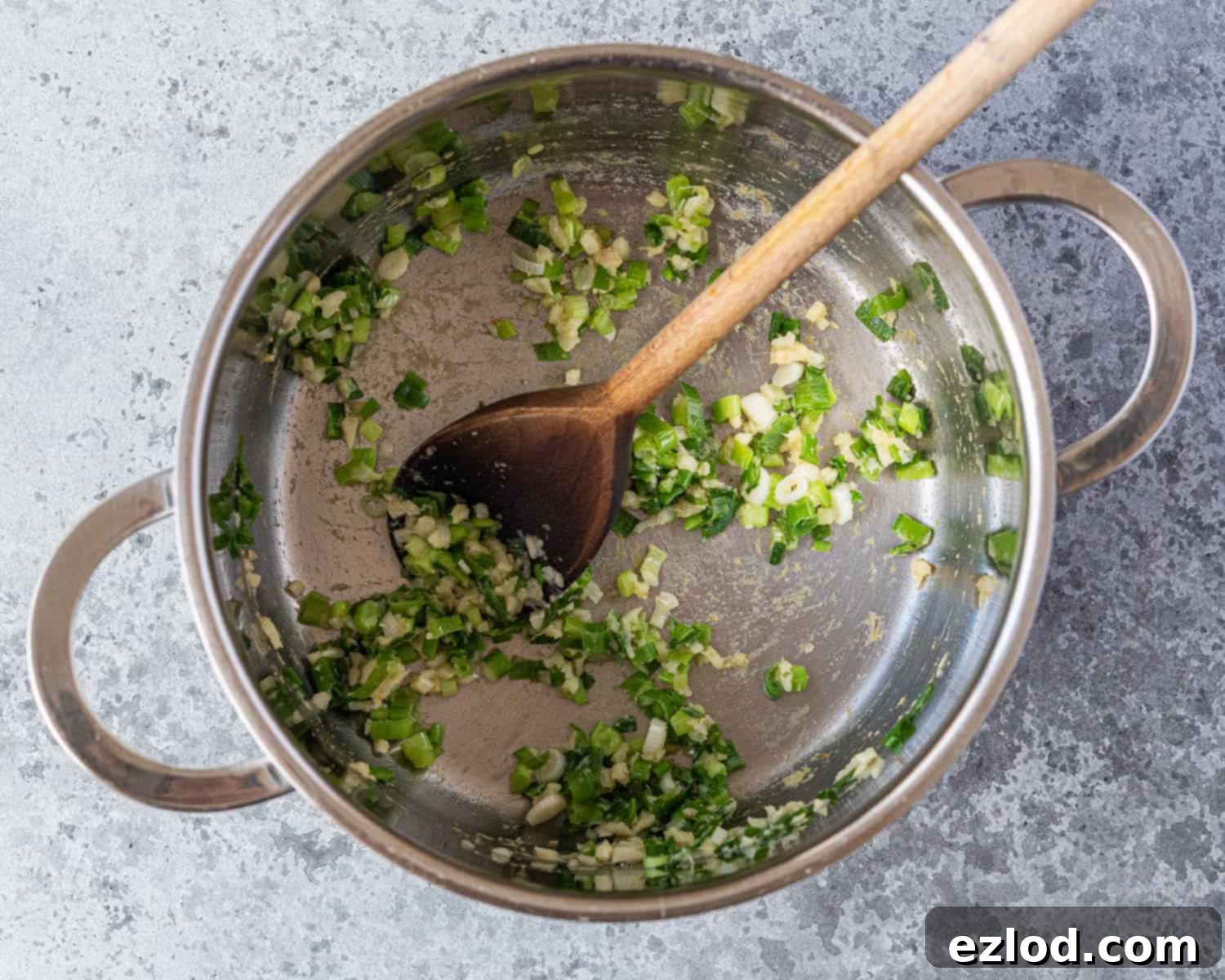
Step 2: Combine Wet and Dry Ingredients
Once your aromatics are fragrant, it’s time to build the soup base. Pour in the soy sauce and toasted sesame oil, stirring well to combine with the sautéed aromatics. Next, add the optional chilli flakes and MSG (if using). Then, introduce the liquids: low-sodium vegetable stock and creamy full-fat tinned coconut milk. Stir everything together until well incorporated. Finally, add your chosen noodles, frozen edamame, and frozen sweetcorn to the pot. Give it all a good stir to ensure the noodles are submerged and separated.

Step 3: Simmer to Perfection
Bring the entire mixture up to a gentle simmer. Allow it to cook for approximately 5-10 minutes, or until the noodles are perfectly tender. The exact cooking time will depend on the type and thickness of noodles you’re using, so keep an eye on them. If you’re incorporating tenderstem broccoli, add it during the last 4 minutes of cooking, allowing it to steam directly in the simmering broth. Alternatively, you can steam it separately and add it as a garnish at the end. Taste the broth and adjust seasonings if necessary, adding more soy sauce or stock to your preference.

Step 4: Cook the Gyoza
While the soup is simmering, prepare your vegan gyoza. Cook them according to the package instructions. This usually involves pan-frying them until golden brown and slightly crispy on one side, then adding a splash of water and steaming them until cooked through. This method yields the best texture for topping the soup.
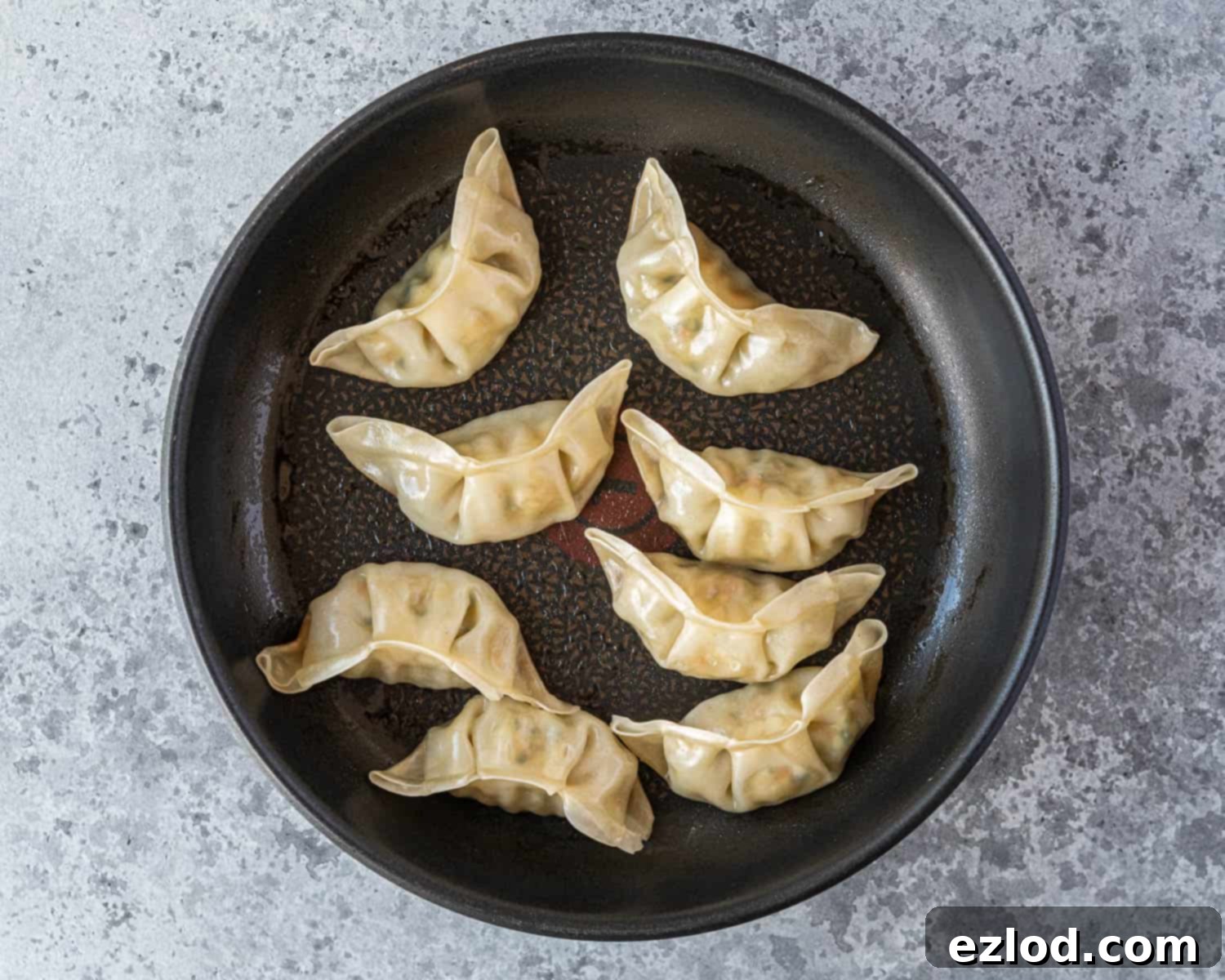
Step 5: Assemble and Serve
Once the noodles are cooked and the gyoza are ready, it’s time to serve! Carefully divide the hot, aromatic soup between two large bowls. Arrange the freshly cooked gyoza artfully on top of the noodles and broth. For an extra touch, garnish with a sprinkle of fresh chopped spring onions, a drizzle of extra sesame oil, or a pinch of extra chilli flakes if desired. Serve immediately and enjoy the comforting warmth and rich flavors.
Expert Tips, Substitutions, and Variations for Your Soup
This **Vegan Coconut Gyoza Noodle Soup** is incredibly versatile, making it easy to adapt to your taste, dietary needs, and whatever ingredients you have on hand. Here are some expert tips and creative variations to make it uniquely yours:
Vegetable Customization
- Leafy Greens: Stir in a handful of fresh spinach, bok choy, or kale during the last minute of cooking until just wilted. They add nutrients and a lovely vibrant green color.
- Mushrooms: Sliced shiitake, cremini, or oyster mushrooms are fantastic. Sauté them alongside the spring onions, garlic, and ginger for maximum flavor.
- Root Vegetables: If you enjoy root vegetables, consider adding thinly sliced carrots or parsnips. For harder vegetables like butternut squash or sweet potato, it’s best to roast or steam them separately until tender before adding them to the finished soup.
- Bell Peppers: Thinly sliced bell peppers (any color) can be added with the frozen vegetables for extra crunch and sweetness.
- Quick-Cooking Veg: Snap peas, green beans (halved), or corn on the cob (sliced into rounds) are also great additions that cook quickly in the broth.
Protein Boosts and Enhancements
- Tofu or Tempeh: For an extra protein punch, try pan-frying cubes of firm tofu or tempeh until golden and crispy, then add them to the soup alongside the gyoza. Marinating them in a little soy sauce and ginger beforehand can enhance their flavor.
- Seitan: Sliced seitan, simmered briefly in the broth, offers a chewy, meaty texture for those who enjoy it.
- Edamame: While already listed, a generous amount of edamame adds a significant amount of plant-based protein and fiber.
Flavor Adjustments
- Spiciness: Increase the chilli flakes or add a dash of sriracha or chili oil at the end for more heat. For a smoky depth, consider a pinch of gochugaru (Korean chili flakes).
- Sweetness: If you prefer a slightly sweeter, more authentic Thai-inspired flavor, a small amount of maple syrup or agave nectar (1-2 teaspoons) can be stirred in at the end.
- Acidity: A squeeze of fresh lime juice or a splash of rice vinegar just before serving can brighten the flavors beautifully.
- Herbs: Fresh cilantro (coriander) or Thai basil make excellent garnishes, adding an aromatic finish.
Making it Gluten-Free
Transforming this soup into a gluten-free meal is simple: use gluten-free noodles (such as rice noodles, buckwheat noodles, or gluten-free ramen), swap regular soy sauce for tamari, and ensure that your chosen vegetable stock is certified gluten-free. Always double-check the labels on your vegan gyoza, as some brands may contain wheat in the wrapper.
Making it Low-Sodium
To reduce the sodium content, ensure you use a very low-sodium vegetable stock. You can also opt for low-sodium tamari instead of regular soy sauce and taste the soup before adding any extra salt. Rely on the fresh aromatics and the natural flavors of the vegetables and coconut milk to carry the dish.
Can I Make This Soup in Advance or Freeze It?
Unfortunately, this **Vegan Coconut Gyoza Noodle Soup** is best enjoyed immediately after preparation. The noodles, particularly thin varieties, tend to absorb a significant amount of liquid and can become mushy if left to sit in the broth for too long. For this reason, it also does not freeze well, as the texture of the noodles and gyoza would degrade upon thawing and reheating.
However, you can do some smart meal prep to speed up the process on the day of cooking. You can chop your fresh aromatics (spring onions, ginger, garlic) in advance and store them in an airtight container in the fridge. You could also pre-cook and chop any harder vegetables. This way, when you’re ready for your soup, the cooking time will be even faster, ensuring you get that fresh, delicious taste every time.
Serving Suggestions for Your Coconut Gyoza Noodle Soup
This soup is a wonderfully complete meal on its own, offering a perfect balance of carbohydrates, proteins, and vegetables. However, if you’re looking to round out your meal or serve it for a larger gathering, here are a few ideas:
- Fresh Herbs: A generous sprinkle of fresh cilantro, chopped mint, or Thai basil adds a burst of freshness and aromatic complexity.
- Chili Garlic Oil: For an extra layer of spice and flavor, a drizzle of homemade or store-bought chili garlic oil is fantastic.
- Lime Wedges: Serve with fresh lime wedges on the side, allowing diners to squeeze a bit of juice into their bowls for a bright, tangy finish.
- Crispy Shallots or Fried Garlic: These add a delightful crunch and extra savory depth as a topping.
- Side Salad: A simple, light green salad with a sesame-ginger dressing would complement the soup beautifully.
- Steamed Rice: While the soup contains noodles, a small side of fluffy jasmine rice can be comforting and help soak up any extra broth.
The key is to enjoy it hot, fresh, and exactly how you like it!
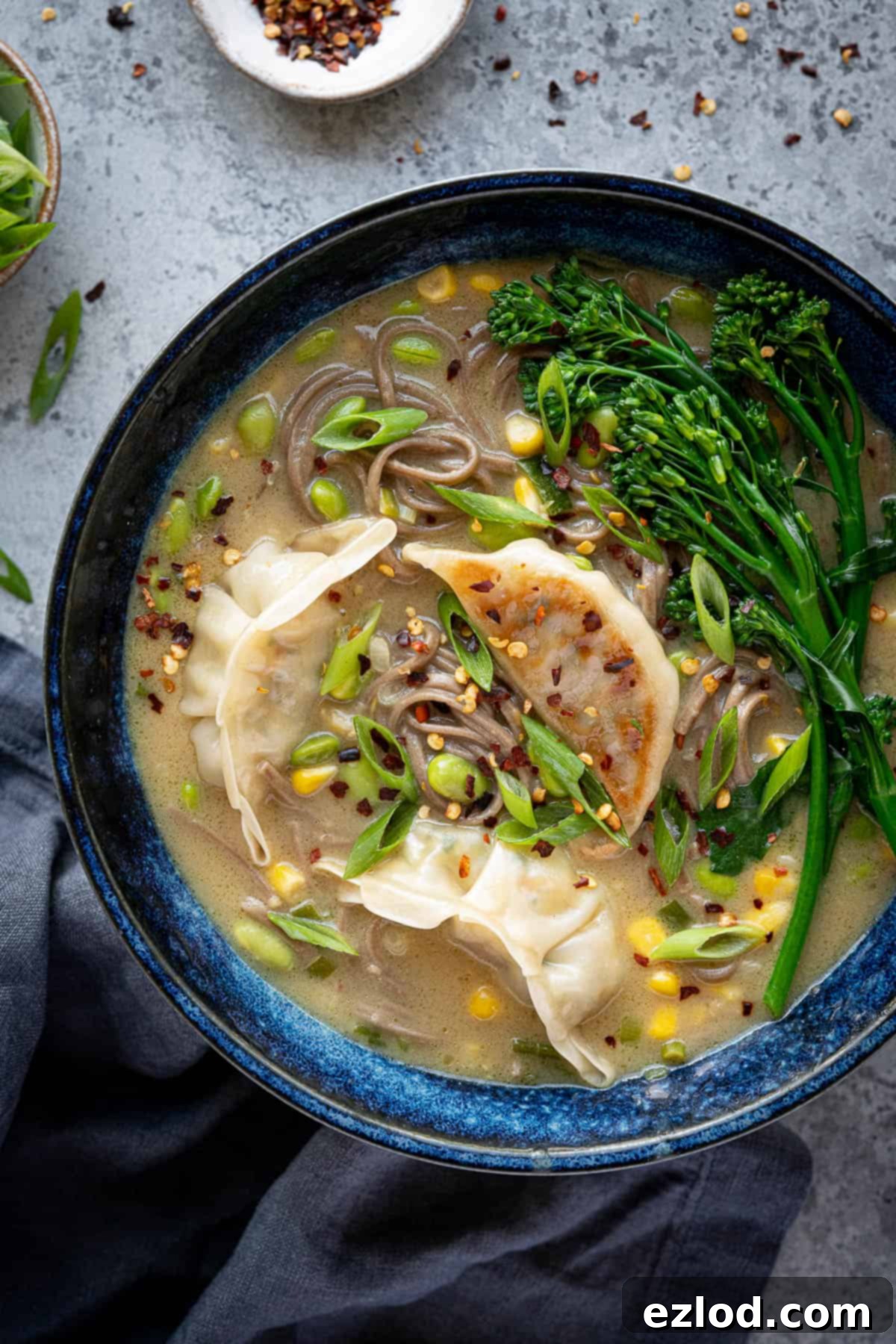
More Delicious Vegan Soup Recipes to Explore
If you’ve fallen in love with the comforting simplicity of this Coconut Gyoza Noodle Soup, you’ll be thrilled to discover more heartwarming vegan soup creations. Expand your culinary horizons with these other fantastic plant-based recipes:
- Creamy Vegetable Rice Soup
- Cheesy Vegan Broccoli Soup
- Creamy White Bean Soup
- Spinach, Lentil and Butter Bean Soup
- Creamy Vegetable Chickpea Soup
- Vegan Corn Chowder
- Spiced Carrot and Pumpkin Soup
- Quick Black-Eyed Bean Soup
We hope you enjoy making this incredible Vegan Coconut Gyoza Noodle Soup! If you tried this recipe, we’d love to hear from you. Please rate it, leave a comment below, or share your creation on Instagram by tagging @domestic_gothess and using the hashtag #domesticgothess. Your feedback inspires us!
All images and content on Domestic Gothess are copyright protected. If you want to share this recipe, please do so by using the provided share buttons. Do not screenshot or post the recipe or content in full; instead, include a link back to this post for the complete recipe details.
Vegan Coconut Gyoza Noodle Soup
A quick, easy, and incredibly delicious vegan soup featuring creamy coconut broth, savory gyoza, and tender noodles. Perfect for a hearty lunch or dinner on busy days.

Course: Main Course, Soup
Cuisine: Vegan, Asian-Inspired
Keyword: Soup, Noodles, Gyoza, Vegan, Coconut
Prep Time: 10 minutes
Cook Time: 15-20 minutes
Total Time: 25-30 minutes
Servings: 2 people
Author: Domestic Gothess
Ingredients
- 1 teaspoon oil (e.g., sesame or neutral cooking oil)
- 4 spring onions (scallions), thinly sliced, plus extra for garnish
- 4 cloves garlic, peeled and crushed (fresh or frozen)
- 1 Tablespoon grated fresh ginger (fresh or frozen)
- 1 Tablespoon toasted sesame oil
- 1 Tablespoon soy sauce (use tamari for gluten-free)
- ½ teaspoon chilli flakes (optional, adjust to taste)
- ¼ teaspoon MSG (optional, for enhanced umami)
- 750 ml (3 cups) low sodium vegetable stock
- 180 ml (¾ cup) full fat tinned coconut milk
- 125 g (4 ½ oz) dried noodles (approx. 2 nests, e.g., udon, wholewheat)
- 110 g (¾ cup) frozen edamame
- 110 g (¾ cup) frozen sweetcorn
- 8-10 vegan gyoza (store-bought, ensure vegan-friendly)
- Optional: 8 tenderstem broccoli florets
Instructions
- Heat the teaspoon of oil in a large pan or pot over a low to medium heat. Gently fry the thinly sliced spring onions, crushed garlic, and grated ginger for 2-3 minutes until softened and fragrant. Be careful not to brown the garlic.
- Add the soy sauce, toasted sesame oil, chilli flakes (if using), and MSG (if using) to the pan, stirring to combine with the aromatics.
- Pour in the low sodium vegetable stock and full-fat tinned coconut milk. Stir well to create a smooth broth.
- Add the dried noodles, frozen edamame, and frozen sweetcorn to the simmering broth. Stir to submerge the noodles.
- Bring the soup to a gentle simmer and cook for 5-10 minutes, or until the noodles are tender to your liking. Cooking time will vary based on noodle type. If adding tenderstem broccoli, add it during the last 4 minutes of cooking.
- While the soup is cooking, prepare the vegan gyoza according to their package instructions. This often involves pan-frying then steaming.
- Once the soup is ready and the gyoza are cooked, divide the hot soup evenly between two bowls. Arrange the cooked gyoza on top.
- Garnish with extra fresh spring onions, a drizzle of sesame oil, or additional chilli flakes if desired. Serve immediately and enjoy!
Notes
For more detailed tips on substitutions, variations, and gluten-free options, please refer to the main article above.
